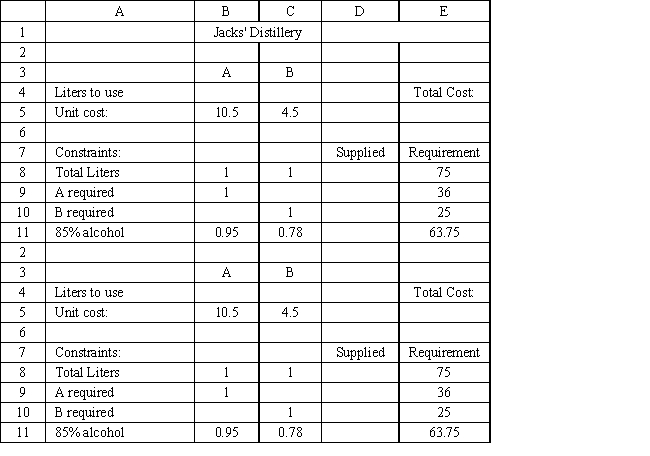Exhibit 3.3
The following questions are based on this problem and accompanying Excel windows.
Jack's distillery blends scotches for local bars and saloons. One of his customers has requested a special blend of scotch targeted as a bar scotch. The customer wants the blend to involve two scotch products, call them A and B. Product A is a higher quality scotch while product B is a cheaper brand. The customer wants to make the claim the blend is closer to high quality than the alternative. The customer wants 50 1500 ml bottles of the blend. Each bottle must contain at least 48% of Product A and at least 500 ml of B. The customer also specified that the blend have an alcohol content of at least 85%. Product A contains 95% alcohol while product B contains 78%. The blend is sold for $12.50 per bottle. Product A costs $7 per liter and product B costs $3 per liter. The company wants to determine the blend that will meet the customer's requirements and maximize profit. 

-Refer to Exhibit 3.3. What formula should be entered in cell D11 in the accompanying Excel spreadsheet to compute the total liters of alcohol supplied?
Definitions:
Learning Percentage
A measure indicating the rate at which performance or productivity improves due to learning and increased proficiency over time.
Operations Management
Operations Management is the administration of business practices aimed at ensuring maximum efficiency within an organization, focusing on managing processes and converting materials and labor into goods and services as efficiently as possible.
Learning Percentage
The rate at which productivity improves as workers gain experience, often leading to reduced time and cost to complete tasks.
Operations Management
The field that deals with designing, overseeing, and controlling the process of production and redesigning business operations in the production of goods and services.
Q9: A company wants to build a new
Q10: Deviational variables<br>A) are added to constraints to
Q14: The feasible region for the pure ILP
Q16: What to produce in a market economy
Q38: A company has four projects, numbered 1
Q38: Which type of spreadsheet cell represents the
Q56: Refer to Exhibit 7.4. Based on the
Q65: Economic resources are also called:<br>A) free gifts
Q125: Purposeful behaviour suggests that:<br>A) everyone will make
Q248: In drawing a budget line it is